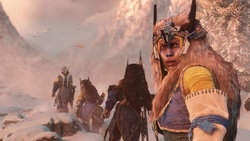
A group of traveling tribe members
A tribe refers to a society of families or communities who share distinct cultural ties, usually inhabiting a defined territory or region. Human societies in Horizon Zero Dawn are referred to as tribes.
The cultures, economies, religions, and governments of these tribes vary widely. While some tribes are small and humble, others are bigger, wealthier, and have more complex systems of government and militaries.
There are three tribes that feature heavily within Horizon Zero Dawn: the Nora, the Carja, and the Oseram. Aloy's tribe, the Nora, are a reclusive hunter-gatherer society. The Banuk tribe features prominently in The Frozen Wilds expansion.
History

|
"The lesson will be taught in due time, Aloy. Until then, we wait." This article contains heavy spoilers. Read ahead with caution.
|
Following the events of the Faro Plague, the human population was eradicated as was all biological life on Earth. Foreseeing this unavoidable extinction, part of Project Zero Dawn involved the eventual repopulation of Earth, with the ELEUTHIA subordinate function in charge of this. Human and animal zygotes were stored cryogenically in Cradle facilities, with the APOLLO subordinate function meant to educate them on humanity's past once the new humans reached kindergarten age. However, Ted Faro's purging of the APOLLO function meant that the new humans were without any knowledge of the former civilization or how to survive outside of the Cradles. When the food supplies in the Cradles were eventually depleted, the new humans were forced out despite lacking the knowledge necessary to survive in a world now dominated by machines.
The loss of the APOLLO function resulted in the loss of millennia of technological advancement and knowledge, leaving the new humans devoid of any understanding of the previous civilizations. However, humanity did learn how to survive and thrive, and by the start of the fourth millennium, unique societies referred to as tribes were formed in various areas across the world. They adopted ways of life similar to their ancient ancestors, hunting and gathering food and resources, both from the natural world and from machines, and some eventually rediscovered agriculture. Because the information regarding the extinction of the first age of humanity was lost, these new societies were unaware of the origin of the machines and of the disappearance of the Old Ones, and the ruins and artifacts left behind were either avoided or explored and salvaged.
The true reason for the disappearance of the Old Ones remained a mystery until Aloy and Sylens learned of the Faro Plague and Project Zero Dawn in 3040.
Overview
Compared to the technological and societal advancement of the Old Ones, the tribes of the 31st century are far less advanced, resembling ancient indigenous cultures. Although lacking in the technology developed by their predecessors, the tribes have evolved into unique societies, each with their own customs, laws, religions, and hierarchies.
A few tribes have assumed a sophisticated reputation. The Carja developed construction technology that allowed them to build permanent human settlements (such as their capital city, Meridian) and construct working cranes and elevators. Agriculture is a major part of their lifestyle, as is trading and mining. The leader of the Carja is a monarch called theSun-King, and they worship the sun as a sort of divine entity. From an economic and militaristic standpoint as well, they are considered the most advanced of the featured tribes. Also considered an advanced tribe are the Oseram, who are known for their craftsmanship and metalwork; they have invented powerful weapons resembling guns and cannons.
Other tribes remain hunter-gatherer societies, foraging and hunting for food and resources. The Nora tribe is a prime example, and their technology is developed solely for the purpose of hunting. They are a reclusive society, with tribe members rarely leaving Nora territory. Their leaders, the Matriarchs, are responsible for governing the tribe; they are also religious leaders and guide the tribe in the worship of a goddess they call All-Mother. The Banuk are another reclusive, hunter-gatherer tribe who rarely venture outside their territory despite being a nomadic society.
Relations between tribes can range from friendly to hostile: the Carja infamously waged war with the Nora and Oseram. Later on, the Carja and Oseram became closely allied. Other tribes prefer an isolationist policy, though trade may still occur.
Known Tribes
- Banuk
- Carja
- Shadow Carja (faction)
